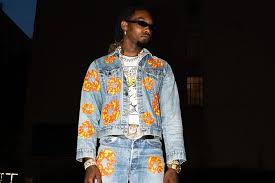The Art and Activism Woven Into Denim Tears
Tremaine Emory, founder of Denim Tears, stands as a cultural architect bridging art, fashion, and Black history. His creative philosophy transcends aesthetics; it’s a form of activism stitched into every garment. Emory views clothing as both storytelling and protest—a wearable archive of identity. His work captures pain and pride, rebellion and remembrance, all interwoven with Denim Tears’s rugged honesty. Each collection feels like a chapter in a broader narrative of African American experience. Through his designs, Emory reclaims fashion as a platform for dialogue, compelling audiences to confront uncomfortable truths while celebrating resilience and cultural brilliance.
2. Denim Tears: Fashion as a Social Canvas
Denim Tears isn’t just a brand; it’s an artistic vehicle for historical consciousness. Emory uses fashion as a social canvas to document the Black journey from oppression to empowerment. His use of denim—America’s quintessential fabric—symbolizes both labor and legacy, a reminder of cotton fields and industrial struggle. Through powerful imagery, such as cotton wreath motifs, he transforms trauma into beauty. The clothes become tactile lessons in history, worn by those who dare to remember. Denim Tears challenges consumerism by insisting that every purchase carries cultural weight and every thread tells an ancestral story.
3. The Cotton Wreath as a Cultural Emblem
One of Denim Tears’ most striking motifs is the cotton wreath, an emblem of both suffering and strength. Emory’s decision to place cotton—once a symbol of slavery—onto denim apparel reclaims its meaning. What was once an emblem of forced labor now stands as a mark of remembrance and resistance. The wreath’s circular form evokes continuity and unity, suggesting that Black identity cannot be erased but constantly reborn. Through this design, Emory weaves a dialogue between pain and power, making fashion not just decorative but deeply reflective of the Black American experience.
4. Collaboration and Cultural Crossroads
Tremaine Emory’s collaborations extend his vision into global consciousness. Partnerships with brands like Levi’s, Converse, and Stüssy fuse streetwear with social commentary. These collaborations amplify his message—making cultural storytelling accessible to a wider audience. Rather than diluting his ideas, such partnerships magnify them through iconic silhouettes and global visibility. By merging mainstream fashion with ancestral narrative, Emory redefines collaboration as conversation. Each joint project becomes a bridge between commerce and consciousness, using popular culture as a conduit for historical truth and social critique.
5. The Influence of Black Art and Music
Emory’s vision draws heavily from the lineage of Black art, music, and literature. His creative lens reflects the rhythm of jazz, the rebellion of hip-hop, and the depth of Black spirituality. Denim Tears collections often feel like visual mixtapes, sampling cultural icons and historical references. He honors figures like James Baldwin, Nina Simone, and Jean-Michel Basquiat—not through imitation but interpretation. In his world, fabric becomes rhythm, color becomes emotion, and design becomes dialogue. Through this synthesis, Emory preserves and projects the cultural soul of Black creativity into the future.
6. Storytelling Through the Lens of Pain
For Emory, pain is not an endpoint but a point of origin. Denim Tears reimagines collective trauma as a creative force, confronting America’s racial past through honesty rather than avoidance. His garments act as testimonies—reminding wearers of untold stories and unseen sacrifices. By facing discomfort, Emory invites healing. The visual language of Denim Tears echoes generational grief while proposing transformation. Each thread whispers of survival, turning wounds into wisdom. This commitment to truth makes his fashion more than wearable—it’s a ritual of remembrance, stitched with reverence and rebellion in equal measure.
7. Community, Identity, and Representation
Tremaine Emory’s creative mission extends beyond individual expression; it centers community. Denim Tears operates as a collective narrative of Black existence rather than a singular designer’s voice. His approach celebrates representation not as trend but necessity. Every photoshoot, campaign, and collaboration highlights real stories—Black families, artists, and activists. This inclusivity grounds the brand in authenticity and purpose. By centering community identity, Emory challenges fashion’s historical exclusion and reclaims space for those once marginalized. Denim Tears thus becomes both a mirror and a megaphone for a shared cultural heartbeat.
8. Spirituality and Ancestral Dialogue
Spirituality runs through Denim Tears like an invisible thread. Emory’s designs converse with ancestors—seeking guidance, protection, and purpose. The sacred and the stylish coexist in his work, blurring boundaries between art and ritual. His collections often evoke African diasporic traditions, referencing rituals of mourning, celebration, and rebirth. Each piece feels consecrated, carrying emotional and ancestral weight. In this spiritual dialogue, fashion transcends vanity—it becomes vessel. Through Denim Tears, Emory channels unseen histories and honors ancestral spirits, transforming contemporary streetwear into a sacred language of remembrance and gratitude.
9. Confronting Commercialism with Conscience
In a fashion industry dominated by profit and performance, Emory stands apart through moral conviction. Denim Tears challenges the notion that style must compromise substance. His refusal to separate aesthetics from ethics makes his brand a moral compass within the commercial landscape. Emory’s activism questions the exploitation that underpins much of global fashion—especially its racial and labor inequities. By embedding social consciousness into his business model, he transforms consumption into reflection. Denim Tears asks buyers not just what they wear, but why—making every garment a quiet act of protest.
10. Legacy and the Future of Denim Tears
Tremaine Emory’s impact extends beyond fashion—it’s cultural, educational, and generational. Denim Tears Hoodie serves as a blueprint for how art can confront history and inspire progress. His legacy lies in teaching the world that beauty and resistance can coexist, that fabric can speak, and that storytelling heals. As he continues to expand his creative reach, Emory remains guided by memory and mission. Denim Tears stands as living proof that fashion can carry freedom’s flame. Through his work, Emory ensures that the stories of the past continue to shape the style—and the soul—of the future.




Leave a Comment